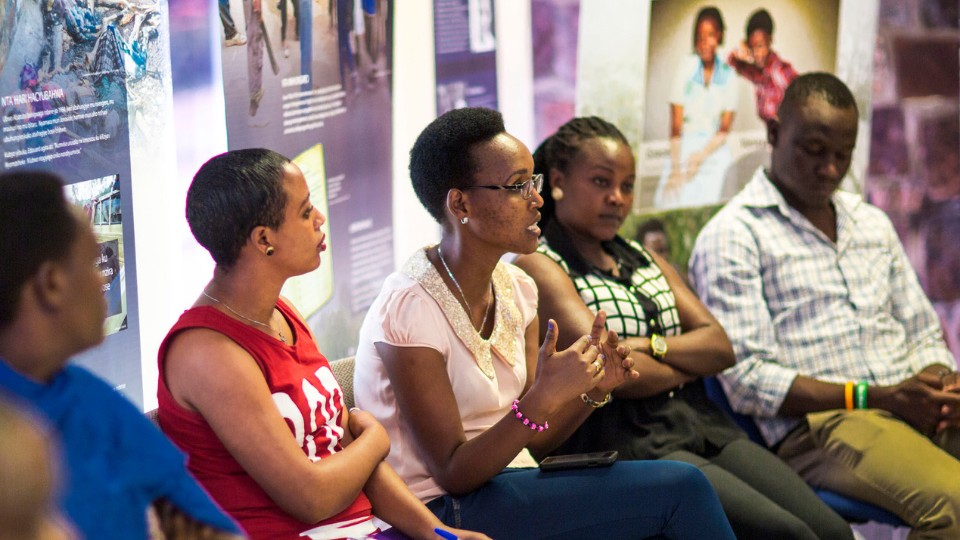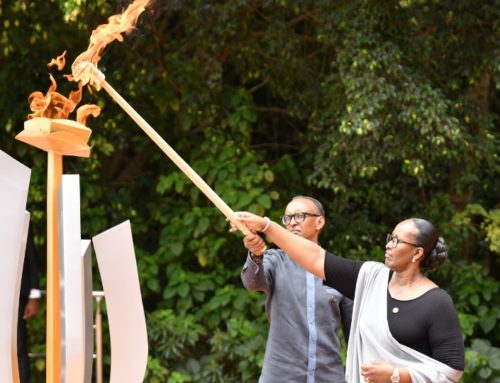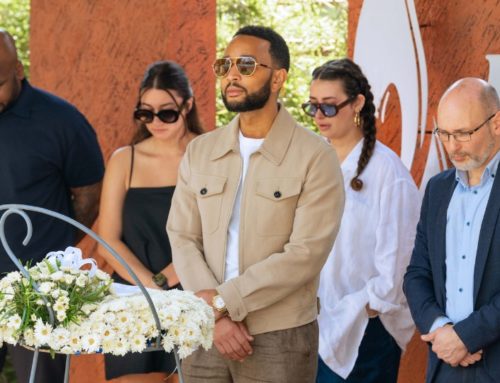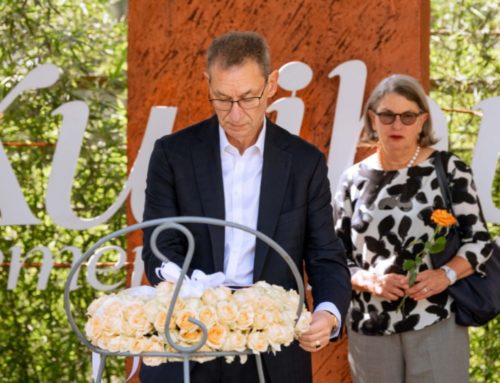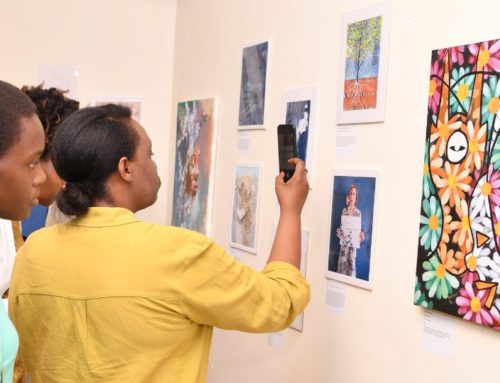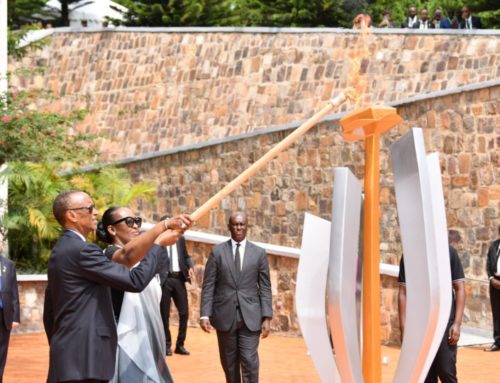In this comment piece, Aegis Trust Founder and Deputy Chair Dr James Smith reflects on ways in which the memory of the Genocide against the Tutsi is helping to build peace through the Kigali Genocide Memorial and beyond.
On 7 April 2024 – the 30th anniversary of the start of Rwanda’s Genocide against the Tutsi – Michela Wrong asserted in the Spectator that the Kigali Genocide Memorial I helped establish in 2004 is ‘part of Rwanda’s problem’, contributing to a destabilising ‘recipe for disaster’ in Rwanda and the region. I have spent decades working with a dedicated team in Rwanda to ensure the Memorial would play precisely the opposite role.
Contrary to widespread opinion, it was not born from a plan of the ruling Rwandan Patriotic Front (RPF) to support their narrative of the genocide, but in tears, grief and a practical need for a burial site for around a quarter of a million Tutsi murdered in Rwanda’s capital in 1994. A project of Kigali City Council, it only later fell under central government.
When in 2001 my brother Stephen and I first visited the site, bones and skulls were stacked floor to ceiling in a new building adjacent to the mass graves. Two years later the Aegis Trust, that I led, agreed to work with the City Council in its development.
Standing in April rains, I will never forget the sorrow on the faces of survivors reburying the dead that were being found in shallow graves and latrines around the city. They convinced me of the Memorial’s first priority: to be a place of dignified remembrance which widows and orphans might call home, knowing the memory of their loved ones was safe in perpetuity.
Aegis was invited to Rwanda in 2001 by the Rwandan Minister of Culture. I asked what he wanted with this little genocide prevention NGO from the UK, which had grown out of the National Holocaust Museum that Stephen and I had established five years earlier.
“In Rwanda we don’t have previous history of genocide, unlike Europeans who have done this often,” he said. “We require know-how from those who have established memorials before.”
I raised a concern based in European experience. “Governments construct memorials which can have serious consequences if they encourage division. Look at Bosnia. Two generations after World War II the memory of atrocities was weaponised, inflaming further conflict and genocide in the 1990s.” I relayed my fear that if Rwandan memorials led to children of perpetrators feeling blame, and stoked resentment in children of survivors, mistrust could explode in coming generations.
“Do not accuse children of perpetrators,” the Minister agreed. “However, do accuse ideology that leads to genocide.” That became Aegis Trust’s brief from the Rwandan Government.
Unburied human remains were an early challenge. “No-one will believe it happened. Mass graves hide evidence of genocide,” one survivor told me. She wanted more victims to be exhumed and seen. “If denied or forgotten it may happen again to our children.” Such fears were not unfounded; denial and revisionism are now rampant.
An equally strong view – held by the President of Ibuka, the survivors’ association, among others –
rejected exposing bones. How could these opposite views be resolved? I proposed a small number of bones and skulls be laid to rest under glass tops in a sanctuary within the subterranean part of the memorial. The ‘burial’ chambers were humanised with photographs and clothes of victims. It offered a dignified resting place to satisfy those demanding burial, while providing visibility for those who argued that such evidence of genocide should be witnessed. The vast majority of the human remains were stored out of sight by the time the memorial opened in April 2004. A few months later Ibuka laid them to rest in mass burials.
Michela Wrong asserts she has observed these exhibits changing over time to be less in-your-face. In Kigali for the 30th commemoration, I checked. Aside from one item of clothing replaced due to conservation issues, the bones and artefacts have remained unchanged in twenty years.
Wrong says the Memorial glosses over Rwanda’s civil war and misses context, with the result that ‘the genocide appears to come out of nowhere’. A third of the main exhibition is devoted to pre-genocide context and has always referred to the civil war. It shows propaganda which portrayed the Rwanda Patriotic Front (RPF) as an existential threat to Hutus and accused all Tutsi of complicity. What it does not include, as Wrong more specifically objects, is reference to what she describes as the RPF ‘ethnically cleansing the population’ in the early 1990s.
Leaving aside the veracity of this assertion about the RPF, there is never one right way for a museum to frame complex events. But some ways are patently wrong.
Consider Holocaust memory. Jews were blamed by Nazis for communism. Holocaust museums often display anti-communist propaganda as part of the context. However it became popular in some European States to say that Jewish Bolsheviks committed atrocities first, before Nazis planned extermination of the Jews. They add that nationalists in eastern Europe joined in the killing sprees because they were angry with the Jews. The Holocaust was relativised into a conflict of two sides, both of which committed atrocities. This ‘double genocide’ narrative diminishes the gravity of Nazi crimes and the role played by racist ideology. It also deflects blame from perpetrators, implying Jews brought the Holocaust on themselves.
Likewise, Wrong’s assertion that Tutsis committed ethnic cleansing before the genocide against them transfers blame from the radical Hutu government on to the victims of genocide, implying Tutsis were architects of their own destruction.
Hutus died for many reasons in the 1990s: as combatants, as genocidaires, as heroic opponents of the genocidal regime, as civilians killed during the civil war, and from disease in refugee camps. In none of these tragic circumstances were Hutus victims of genocide, as there was no intent to destroy them because they were part of an ethnic group.
Is there a time and place to remember victims of the civil war in Rwanda? Yes. In a genocide museum? In my view, no.
Understanding the pathway to genocide is key for prevention. The seeds of genocide in Rwanda did not begin with civil war in 1990. In the Memorial we describe how from 1959 to Rwanda’s independence and after, regular massacres drove hundreds of thousands of Tutsi into exile.
What accounts for ethnic violence after 1959 when historically Rwanda was relatively peaceful? Again, the Memorial aims to shed light. Colonists divided Rwandan society using European racial myths, suggesting Tutsi were outsiders from Ethiopia, intent on suppressing the Hutu.
These racial myths are still thriving and deadly, not least across the border in DRC where ‘aging genocidaires’, whose threat Wrong downplays, have seeded anti-Tutsi thinking in a new generation. Horrific violence results against Congolese Tutsi. As I write, I have been sent a video of a Tutsi man being stripped, beaten, spat on and stoned to death while an assembled crowd joins in.
To encourage critical thinking and shared values among Rwanda’s second generation after the genocide, and to prevent division being an unintended outcome at the Kigali Genocide Memorial, I asked survivor Freddy Mutanguha to develop a peace and values education programme there. The Rwanda Education Board integrated this peace education into Rwanda’s national schools curriculum in 2016.
Wrong makes no reference to this pillar of Aegis’ work, instead asserting the Memorial ‘actively undermines Rwanda’s professed commitment to reconciling majority Hutus and minority Tutsis’.
The programme has proven successful. Young people started community peace projects, resulting in remarkable reconciliation initiatives uniting survivors, perpetrators and their families. Some youth, both Hutu and Tutsi, gave up plans for armed violence. The Memorial’s effectiveness in peace-building helped persuade UNESCO to inscribe it as a World Heritage Site last year.
Peace education alone is not enough. Research is necessary to build evidence about what contributes to stability. Yet Rwandan voices are barely present in international academic discussions about rebuilding in Rwanda. This is why, with King’s College London and SOAS, Aegis fostered independent research capacity enabling Rwandan scholars to study and publish on post-genocide issues. Their work featured in Nature on 5 April, describing what researchers are discovering that could aid prevention of atrocities in Rwanda and beyond.
Today, leaders from communities in crisis beyond Rwanda’s borders visit the Kigali Genocide Memorial to learn from Rwanda’s experience of peacebuilding after genocide.
“We failed in Rwanda. We failed in Srebrenica. But you are writing a different future,” Ban Ki-moon commented when visiting as United Nations Secretary General. “This memorial serves both as a warning and as a symbol of hope.”

